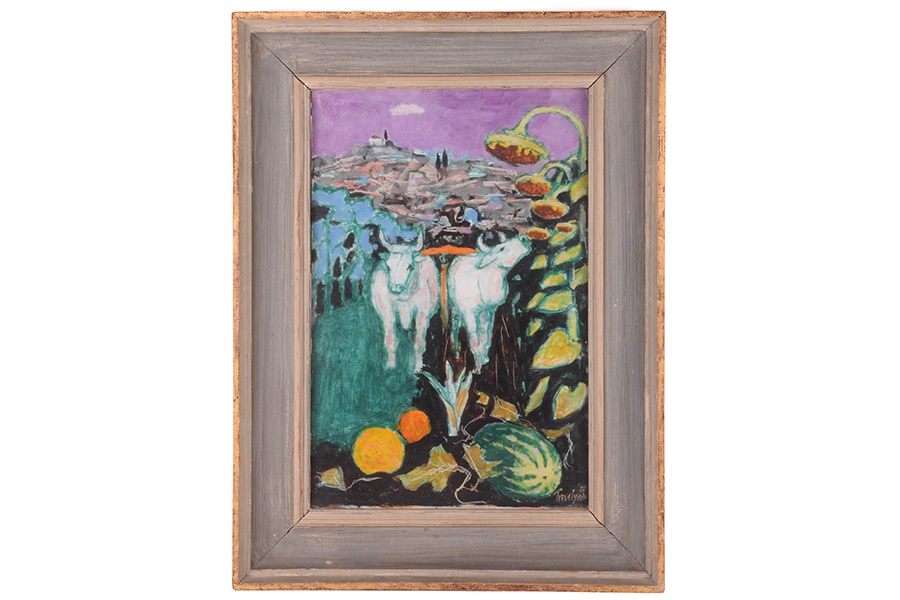A Guide to the Work of Julian Trevelyan
Trevelyan's work was particularly noted for its surreal and abstract nature
28/10/2024
Julian Trevelyan (1910-1988) was a prominent British artist and poet whose work was particularly noted for its surreal and abstract nature. They often combined elements from both landscapes and nature, and often included human figures – blending to create a truly unique and distinctive style. During his decades-spanning career, Trevelyan contributed significantly to British art and his legacy can still be recognised today throughout modern British surrealism.
Julian Trevelyan (1910-1988), 'Two Oxen and Cart'
Born in Hammersmith, Trevelyan’s proclivity for the arts flourished when he moved to Paris to become an artist and study at Atelier Dix-Sept. It was there were Trevelyan studied under Stanley Hayter, developing skills in etching and print making, whilst also working alongside other artists that included Pablo Picasso and Max Ernst – influences from these fellow artists can be seen in his early work such as “Standing Figure with Ace of Clubs” (1933).
Following his studies, Trevelyan returned to the UK where he completed more works that incorporated industrial landscapes with his newfound love for surrealism; “The Potteries” (1938), arguably his most significant piece, is emblematic of Trevelyan’s focus on industrial subjects and truly highlights his ability to combine surrealist and modern elements.
During the Second World War, Trevelyan served as a camouflage officer in the Royal Engineers and continued to paint during this time. Upon his return to Britain, he took particular interest in the impact that the war had on industrial and urban landscapes – this can be seen in his works “Kingston upon Hull” (1941) and “The Tyne at Jarrow” (1943). After the war, Trevelyan settled in Durham Wharf, London, on the banks of the river Thames; the location that became his workshop for over 30 years and was the basis for his “Thames Suite” (1969) collection.
 Julian Trevelyan (1910-1988) British, a pair of oxon sharing a yoke
Julian Trevelyan (1910-1988) British, a pair of oxon sharing a yoke
Julian Trevelyan’s work offers a fascinating exploration of 20th century art – his pieces blend the surreal with the real, and he constantly pushed boundaries in the field of printmaking, seeming to almost innovate at every turn. His work is still celebrated today, with over 100 of his artworks being on display in the collection of the Tate Gallery, demonstrating how his legacy continues to inspire contemporary artists.
THe characteristics of Julian Trevelyan's work:
Dreamlike Quality – a true pioneer of surrealism, many of Trevelyan’s paintings incorporate unexpected juxtapositions and imaginative landscapes. This combination of his works feeling so familiar yet fantastical are what made him such an influential artist.
Architectural Elements – Trevelyan’s interest in the modern world is reflected in his works through his use of industrial and architectural elements. Abstract depictions of cityscapes, bridges and factories were often the subject of Trevelyan’s paintings, engaging with viewer’s emotions and allowing them to form their own interpretations on the piece.
Use of Colour – Trevelyan’s paintings often use a bold, expressive palette creating vibrant contrasts. Rich saturated hues help evoke emotion as well as contributing to the dreamlike quality – the interplay of colours can make a piece seem harmonious or jarring, further adding to the dynamic quality of his work.
Julian Trevelyan (1910-1988), 'Cappadocia'
For appraisals or valuations on any artwork by Trevelyan or his contemporaries, it is always best to talk to an expert. Dawsons have highly experienced team of Valuers who that would more than willing to help you value any artworks you may have.
With a huge international audience, Dawsons will ensure the exposure needed for you to achieve the maximum return in respect of any artworks you may have. Our dynamic in-house marketing, which targets art buyers globally across multiple social media platforms, ensures we achieve the highest returns for our clients.
read more
How Do I Find Out What My Art is Worth?
British Art in the 20th Century
Are you thinking of selling any artwork by Julian Trevelyan?
With a global audience of over 10 million known bidders, Dawsons can secure the best possible prices for you.
Get in touch with an expert Valuer for confidential sales advice, we would be delighted to help:

